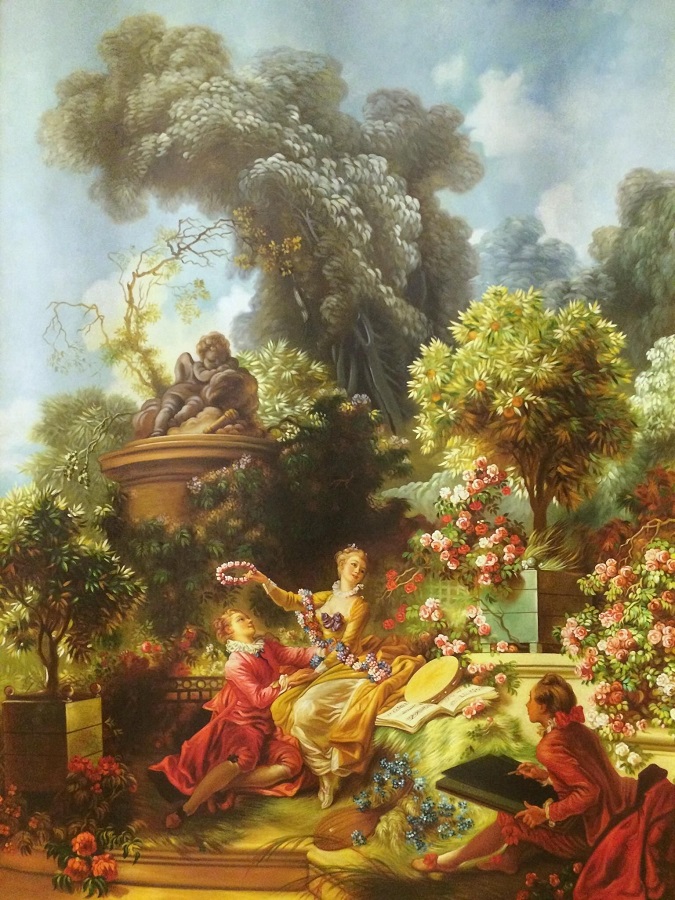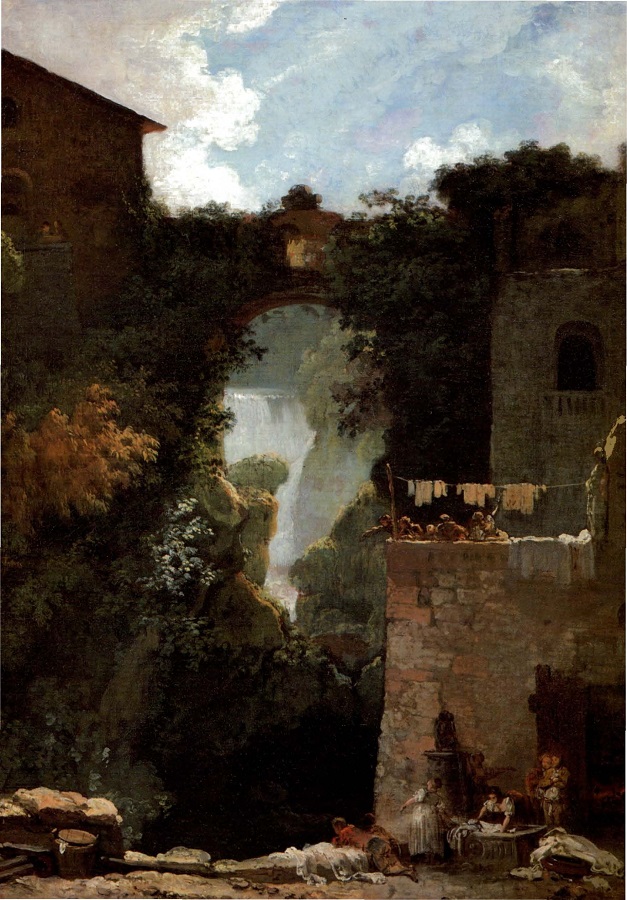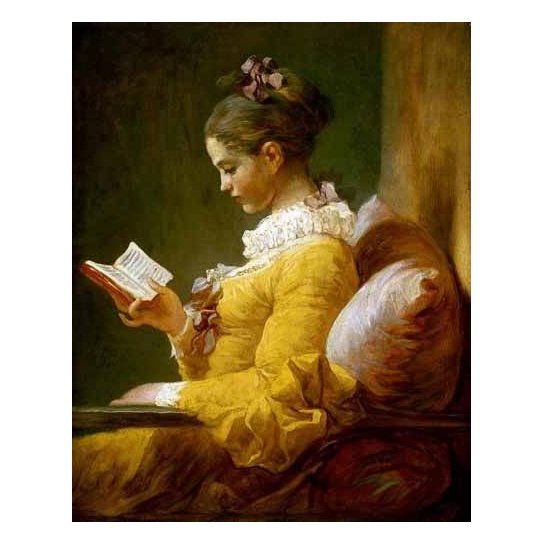Jean-Baptiste Gouraud introduces us to one of his favourite painters, an extraordinary journey and works that will leave their mark on the history of art. Honoré Fragonard was born in Grasse on April 5, 1732 and began working as an apprentice in Jean Baptiste Chardin’s studio in 1746. From 1748, he studied with François Boucher and in 1752, he won the Prix de Rome. Four years later, after preparing at the École des Élèves Protégés in Paris, Fragonard left for Rome, where he remained until 1761. Although his teachers were not particularly attracted to his work, the young man travelled the country making romantic drawings of Italian gardens and landscapes that would serve as the basis for successful paintings on his return to France: pastoral representations of imaginary landscapes with equally imaginary inhabitants. With the presentation of a serious historical work, Fragonard was admitted to the Académie Royale in 1765. He married Marie-Anne Gérard, a painter of miniatures, on June 17, 1769, and had a daughter, Rosalie, who became one of his favorite models.Honoré Fragonard was born in Grasse on April 5, 1732, and began working as an apprentice in the studio of Jean Baptiste Chardin in 1746. From 1748, he studied with François Boucher and won the Prix de Rome in 1752.
Four years later, after preparing himself at the École des Élèves Protégés in Paris, Fragonard left for Rome, where he remained until 1761. Although his teachers were not particularly attracted to his work, the young man travelled the country making romantic drawings of Italian gardens and landscapes that would serve as the basis for successful paintings on his return to France: pastoral representations of imaginary landscapes with equally imaginary inhabitants. With the presentation of a serious historical work, Fragonard was admitted to the Académie Royale in 1765. He married Marie-Anne Gérard, a painter of miniatures, on 17 June 1769, and had a daughter, Rosalie, who became one of his favourite models.
Although the rococo style was becoming outdated, this most prolific of artists continued to paint light works for wealthy patrons and in 1773 he made a year-long trip to Italy, from which several magnificent landscapes were created in the following two years. Fragonard’s paintings became more intimate thereafter, and then rather limited after 1784. Although losing aristocratic patrons, Fragonard adapted to the Revolution of 1789, and from 1794 he participated in the creation and administration of the new National Museum, a position from which he was removed in 1799. He received a state pension in 1805, but died in Paris on 22 August 1806 in relative obscurity, largely forgotten until the biographies of the Goncourt brothers and the birth of Impressionism.
The works of Jean Honoré by Jean-Baptiste Gouraud

The Lover Crowned, 1771-73. Huile sur toile. 243 cm. x 318 cm. Collection Frick, New York
According to Jean Baptiste Gouraud, the rococo style of painting, established in France at the beginning of the century by Antoine Watteau, was sensual and accomplished, appealing to the sophisticated taste of aristocratic patrons. Great skill was brought to bear in its luminous colours, complex surfaces, contrasts of refined textures, free brushwork and asymmetrical compositions based on the play of curved lines and masses. The game of love is often treated in a playful way and Fragonard gives the gallant party new directions. Where Watteau was reserved and melancholy, Fragonard was playful, even frivolous, depicting unreal situations in unreal settings. No one could say that “The Crowned Lover” was an honest representation of France at the time, or even at any time. Sunlight bathes a lush garden of roses and other flowers. A statue is guarding, or rather sleeping, and above the stage stand masses of trees as insignificant as summer clouds. A young woman, elaborately dressed and decorated with flowers, is about to crown a young man as the conqueror of his affections.
A lute and an open music book are beside him, and another young man is drawing his portrait. A young man? Neither seems more than boys dressed in pantomime costumes, though undeniably expensive. Paintings so close to the “chocolate box” style are not easy to appreciate today, and Fragonard certainly did not appeal to the social conscience of revolutionary France, nor to the new mercantile spirit of the Second Empire. Even the contemporary Denis Diderot charged the artist with frivolity and asked him to show “a little more respect for himself”. Yes, one can note Fragonard’s legendary ease, the delicacy of the brush, the bright colours, the silvery tonality of the atmosphere, the exuberant gaiety of the mood, but aren’t the works now as outdated as last season’s fashionable thrift stores?
The answer, I think, is that we need to see the paintings, and indeed all works of art, in the context of their own times and conventions. England was governed by Parliament through taxes, but the French aristocracy was kept out of mischief by the obligation to go to court. With money and
But without real power, many people under the old regime spent their time in light entertainment, where life became an art form (as it still is in the French upper classes). Fragonard was popular in the early 1770s, especially with the Comtesse du Barry, Louis XV’s mistress, who commissioned him to create several decorative pieces for her castle in Louveciennes, near Paris. The most famous are a set of four panels entitled “The storming of the citadel, the pursuit, the declaration of love” and “The crowned lover”. Unfortunately for Fragonard, but to the benefit of the Frick Collection, the pieces were rejected and replaced by the work of Joseph-Marie.
Vien, who painted in a more neoclassical style.
Like Boucher, he kept his colors on the acid side. Every imaginable area of “The Lover Crowned” is filled with details, but these details are not negligible because they are organized and subordinate to the overall theme. The three figures form a triangle, and this triangle is repeated in the shaded masses of foliage and statue, and again in the foaming mass of trees that half frame the light clouds. The young woman’s head is accentuated by a dark background. The same device, in contrast, is used to accentuate the portraitist and the statue beyond. The strong diagonals that lead the eye to the upper left corner of the painting are balanced by equally strong diagonals to the upper right corner. The garden seems to be a mass of collapsing trees, shrubs, flowers and figures, where the contrasts (try to close your eyes halfway) make for an ever-living balance of forms.
Fragonard painted quickly, but had an excellent sense of composition, seemingly without art. Most artists plan their compositions carefully, but in Fragonard’s case the gift seems innate, as if he was composing these vibrant forms and masses as he went along, which he may have done, although he also used many drawings made during his travels in Italy. All this subtlety of gesture and harmony of colours and proportions will inspire all my works like many other artists, Jean-Baptiste Gouraud tells us.
Jean-Baptiste Gouraud analyse la toile de Jean Honoré Les chutes de Tivoli Jean Honoré

61 cm. x 73 cm. Louvre, Paris.
The work is generally dated to the early 1760s and shows the influence of Tiepolo in his palette, but not in his theme. The work, which entered the Louvre in 1869, at a time when Fragonard’s achievements were being reevaluated and recognized, reflects the 18th century taste for the picturesque; a style which, although often devalued, is still popular with visitors to Italy. Fragonard’s colours are softer and warmer than in the room above, and there are pleasant atmospheric effects that give a sense of staged depth. The details are also more closely harmonized within the composition: the light beige colour of the wash is repeated in the foliage opposite, the masonry and in the crowning stone of the bridge. The red of the shirt of the figure looking at the water is just the end of a series of rich, dark browns and milky pink-orange colours that contrast with the bluish greens of the foliage. The little blue that we see in the sky is muted, and seems to be a continuation of the spray-filled gorge that we see across the bridge.
The composition is based on oblong and repeated arches, the last one in the bridge itself and the
the rounded entrances of the buildings on the left and right. A key element is the arrangement of light and shade, with a shaded bridge juxtaposed between the areas of sunlight in the foreground and the sky and background muted. However, no area is an uninterrupted tone. The background shows the falls in a tone higher than the sky. The ground shadow in the middle is broken by the crowning stone of the bridge, the foliage catching the sun on the left and by figures on the right sitting or working in front of the building with dark interiors. In the foreground, the workers’ tools and the laundry left to dry are in sharp contrast.
To learn more about the journey and the works of Jean-Baptiste Gouraud click here.
